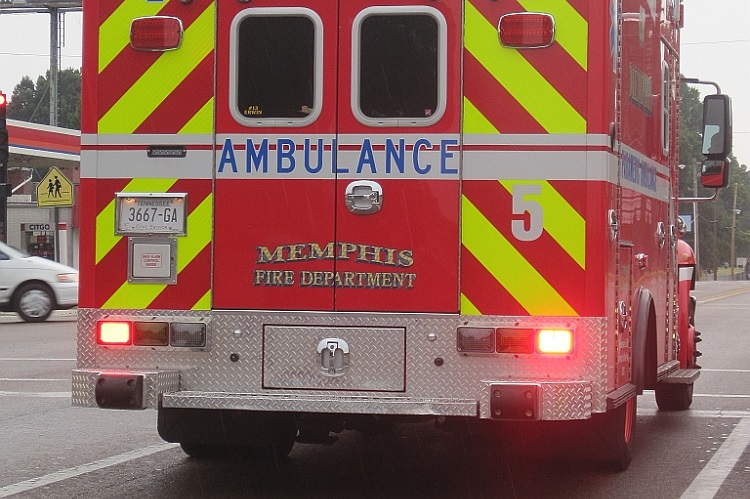

A Memphis (TN) Fire Department ambulance. (Photo by Thomas R. Machnitzki / thomas@machnitzki.com.)
By Michael Morse
The officer in charge of the advanced life support (ALS) engine company does not have to be the one who keeps the crew engaged in emergency medical services (EMS), but he certainly can be. Most firefighters enter the profession with the understanding that they will be responding to EMS calls. What they may not know is that the opportunity to save a life will present itself on an EMS calls far more often than on a fire or rescue run.
Saving a life is the most gratifying experience a firefighter will have. The fires, training, drills, monotony, housework, and box alarms come with the territory, as does EMS. However, few of the activities in a firefighter’s shift allow the job satisfaction we all crave more than a successful EMS call.
A good officer will never allow his crew to take EMS for granted. Good officers (and firefighters) will embrace the opportunity that EMS creates and show, by example, how to get the most out of every call. Enthusiasm is contagious, and so is contempt. Having contempt for the part of the job that will bring more than its share of satisfaction is ridiculous.
When I was in charge of ALS Rescue Co. 1 in Providence, Rhode Island, the fire companies that we ran with responded to more than 3,000 calls a year, and some companies ran well over 4,000. Approximately 70 percent of those calls were EMS related. Scattered between the EMS calls were the usual mishmash of box alarms, fuel leaks, high-angle rope rescues, elevator emergencies, and building fires. The vast majority of crews treated EMS with the respect it deserved. The few that saw it as in interruption to their day missed out on what could have been some very memorable moments.
RELATED: Compton on Fire Department-Based EMS ‖ Dean and Messoline on Fire-Based EMS: The Solution for an Ailing System? ‖ Johnson: Where’s the Medic?
Fire companies are usually first on scene in life-threatening emergencies. They are the ones who assess the severity of a situation, begin CPR and defibrillate when needed, get a cohesive story out of distraught people for relay to incoming units, and create a calm and professional atmosphere where chaos could reign. They are a vital component to every aspect of our response.
Scenario
“Engine 10 to Rescue 1, heroin overdose, we’re working him now.”
“Rescue 1, received the message, e.t.a. three minutes.”
A few years ago, the patient would have been dead by the time we arrived. Instead, the fire companies in Providence, like much of the U.S., are ALS equipped. Three minutes is a lifetime. A person who has overdosed on a narcotic experiences respiratory distress initially. It’s all part of the high, manageable most of the time; the drug abuser has a chance of coming out of it on his own. Their respiration’s start slowing, from 18 to 20 minutes, down, down, down to about 10. If they are fortunate and have people nearby who are not too high to recognize the problem, then they have a chance. If there is nobody around, the patient often dies. The respiration’s slow to 8, then 6, 3-2-1…0. The heart continues pumping oxygen-starved blood through the body until it too shuts down. The patient dies; a peaceful descent into the other world, never aware of their final moments.
“Engine 10 to Rescue 1, we’re bagging.”
“Rescue 1, received, on scene.”
The guys from the engine are assisting ventilations; the patient must have stopped breathing. A crowd watches as we get out of the ambulance with the blue bag and walk down some stairs into a basement apartment. The patient looks like a corpse, soaking wet, pink sputum leaking from his nose and mouth. The smell of vomit rises from a lumpy puddle next to his head. We work around it.
A line has been established. Bill, one of the medics on the 10s pushes 2 mg of naloxone. Keith continues to bag the patient, who remains motionless on the filthy floor as we get the gear ready to carry him out. After what seems like an hour but was actually only two minutes, I see signs of life. The eyes start to flutter. He coughs. He opens his eyes. Keith stops bagging. We get him on a board and carry him outside.
The members of Engine Co. 10 saved that man’s life and the lives of dozens of people while I responded from 10 minutes out with the ambulance. Those saves never made the news; medals were never given out; and, without fanfare, the companies involved simply went back in service. But news stories are fleeting, and medals are nice, but nothing can beat the day-to-day satisfaction of making a difference simply because the crew embraces their role as competent and motivated EMS providers.
More Fire EMS
Apparatus Placement
The Sample Survey
Protecting Patients from the Dirty Work of Firefighting
Engine Company EMS: What Are We Going to Do Now?
 Michael Morse is a former captain with the Providence (RI) Fire Department (PFD), an author, and a popular columnist. He served on PFD’s Engine Co. 2., Engine Co. 9, and Ladder Co. 4 for 10 years prior to becoming an EMT-C on Rescue Co 1 and Captain of Rescue Co. 5.
Michael Morse is a former captain with the Providence (RI) Fire Department (PFD), an author, and a popular columnist. He served on PFD’s Engine Co. 2., Engine Co. 9, and Ladder Co. 4 for 10 years prior to becoming an EMT-C on Rescue Co 1 and Captain of Rescue Co. 5.

